Photographs: Reuters Claude Smadja
Even as Europe continues to go through its economic suicide and the US is stuck in political paralysis -- which could lead to the abrogation of existing tax cuts and mandatory across-the-board budget reductions at the end of the year that would dampen already anaemic growth, or even trigger recession -- China is proving that it is ready to act and do what it takes to sustain its growth.
Beijing has been quite alarmed by the steep fall in economic activity in the last few months.
. . .
How China is handling the economic slowdown
Image: Rowers sit in a 62 metres (203.4 feet) long dragon boat on the Yangtze River in Zigui County, Hubei province.Photographs: China Daily/Reuters
What was initiated as a managed deceleration of the economy to reduce inflationary pressures and deflate a real-estate bubble on the verge of getting out of control acquired, since the end of winter, a dangerous momentum because of the impact of the European crisis.
By June, China's leadership was confronted with the prospect of gross domestic product growth of between seven and 7.5 per cent for 2012, a level too close to the threshold of seven per cent growth it had determined was the minimum needed to maintain social stability.
And some economists consider that real GDP growth for this year would be even lower if the economy were left to its own course.
. . .
How China is handling the economic slowdown
Image: Waiters from a hotel cross a road in Beijing's Central Business District.Photographs: Jason Lee/Reuters
So this has been the call for action.
And action has been swift: some long overdue reform in the financial sector has been taking place, including a reduction in interest rates, relaxation of lending and deposit rate controls, moves towards making credit more accessible to small and medium enterprises, and an increase in spending at the local level.
In that respect, although vague in its modalities, the well-publicised announcement by Changsha, the capital of Hunan, of a $130-billion investment plan is an indication of the approach that the central government intends to take.
. . .
How China is handling the economic slowdown
Image: Yuan notes.Photographs: Reuters
A number of cities throughout China have also announced plans to facilitate the buying of private housing by middle-class people, and to provide incentives for the creation of high-tech industries.
Beijing has three major operational challenges as it tries to get the economy back to an eight to 8.5 per cent growth level.
First, it needs to make sure that any stimulus does not reignite the real estate bubble that was just being tamed and does not lead to wasteful investment.
Such investments load up banks with bad loans -- which have, as it happened, increased since the end of last year.
Second, it has to be careful that this does not boost inflation, although the risk is limited in the present context.
. . .
How China is handling the economic slowdown
Image: A waste collector carries a sack of recycled material as she leaves a construction site in Beijing's central business district.Photographs: Jason Lee/Reuters
Third, it needs to ensure that any stimulus does not widen the wealth distribution gap and consequently aggravate popular frustration and discontent.
Too many projects in the previous stimulus plan ended up benefiting groups around the children of the leadership establishment, and the public became fully aware of that -- thanks in large part to the spectacular expansion of social media in China.
Even more importantly, Chinese leaders have to consider how the stimulus measures they are taking -- or considering taking -- would fit or not fit with their claimed strategic objective: to rebalance the economy towards a more sustainable growth pattern.
. . .
How China is handling the economic slowdown
Image: A labourer walks on coils of steel wire at a steel market in Shenyang, Liaoning province.Photographs: Sheng Li/Reuters
The necessity to move away from an over-reliance on exports, on labour-intensive activities and the construction sector, on the intensive use of natural resources and the fast degradation of the environment is now well-accepted.
There is a growing recognition that the efficacy of the development model that propelled China into becoming the world's second-largest economy has come to an end.
While it took four units of investment to produce one additional unit of GDP until 2008, it now takes five units of investment to produce the same additional unit of GDP.
. . .
How China is handling the economic slowdown
Image: A labourer works at a valve factory in Wenzhou, Zhejiang Province.Photographs: Carlos Barria/Reuters
However, to become more knowledge-based and innovation-driven, to achieve a much larger share of household and domestic consumption in GDP, will mean lower growth rates -- at least during the transition phase of moving from one economic model to another.
This is a very tough call for Beijing's policy makers, who, in the Chinese tradition, consider that their legitimacy -- the Mandate from Heaven -- and their hold on power do not rest on the results of elections but on their ability to deliver economic well-being and social stability to the people, upholding an unwritten social compact.
So we can expect that, depending on the results of the initial stimulus measures that are being taken, the Chinese leadership will err on the side of throwing more resources at the problem if a growth rebound is not perceptible by early fall.
. . .
How China is handling the economic slowdown
Image: Migrant labourers wash a roof near The Bund on the banks of the Huangpu River in Shanghai.Photographs: Aly Song/Reuters
And this, even if some of the measures would mean reverting to a mode of stimulus in contradiction with the stated strategic objective of shifting to a different growth pattern.
China has the means to do this.
It also has a sense of urgency.
Beijing cannot afford to go into the once-a-decade leadership transition of leadership -- at the 18th congress of the Communist Party, supposedly between mid-October and mid-November -- with an economy in dire straits and an already tense social situation that would be aggravated by a more pronounced slowdown.
Another consideration also weighs heavily on Beijing's policy makers' calculations: China is at serious risk of getting old before it gets rich.
This is no longer a theoretical concern.
. . .
How China is handling the economic slowdown
Image: Workers install a watch advertisement in downtown Shanghai.Photographs: Aly Song/Reuters
Over the last 20 years, the average fertility rate in the country has been just 1.28 per cent and what had been, for a number of years, a demographic dividend for China has now become a demographic crisis -- in fact 'a severe and irreversible crisis' according to Chinese experts.
Between now and 2030 -- in just 18 years -- the ratio of working-age people to people aged 60 and beyond will go from 5:1 to just 2:1.
Over the next 10 years, the number of people aged 60 and above will have doubled from 180 to 360 million.
. . .
How China is handling the economic slowdown
Image: A woman walks between buildings at Sanlitun SOHO residential and commercial complex in Beijing.Photographs: Jason Lee/Reuters
To have an adequate pension and welfare system that can cope with these demographic trends requires major reforms to improve the financial market's efficiency.
So, the stimulus will remain and we can expect the leadership in Beijing to try to bring it in line, as much as possible, with the long-term orientation of putting the economy on a more sustainable growth pattern.
But the trade-offs will certainly not be easy, nor will they always be achieved.
However, the bottom line is that as global economic prospects are deteriorating and as the US and Europe are sorely failing the leadership test, the only -- even if partial -- solace comes from China.
The writer is president of Smadja & Smadja, a strategic advisory firm

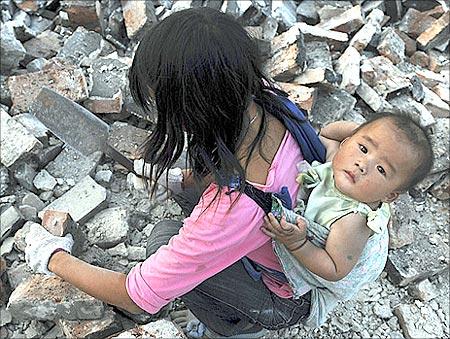
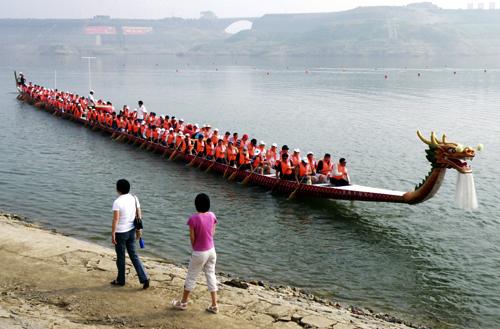
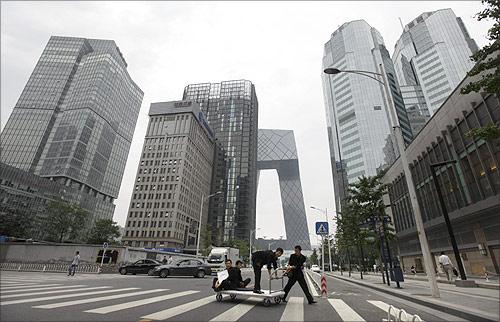
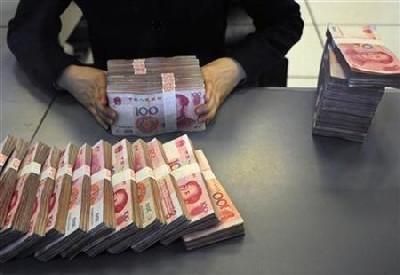
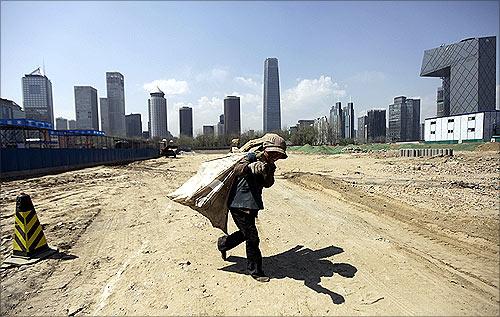

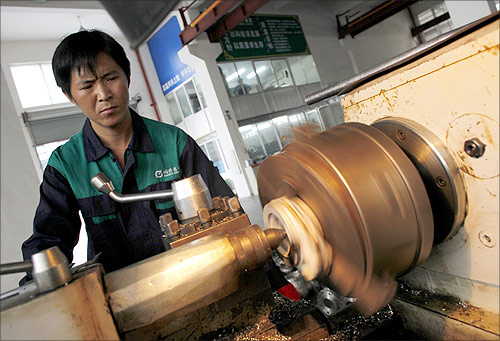
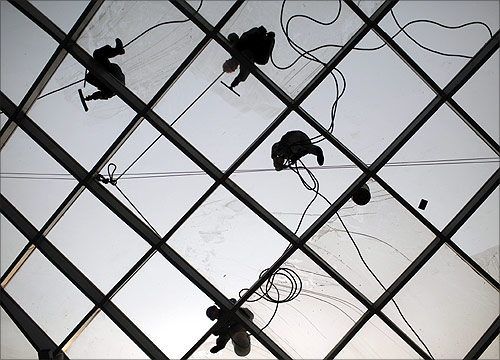

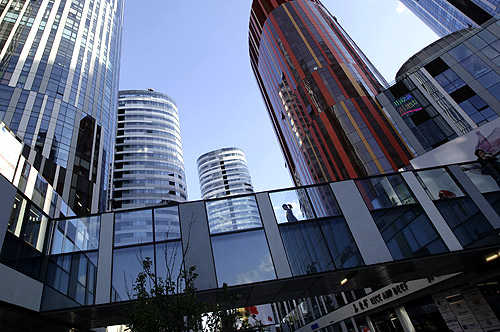

article